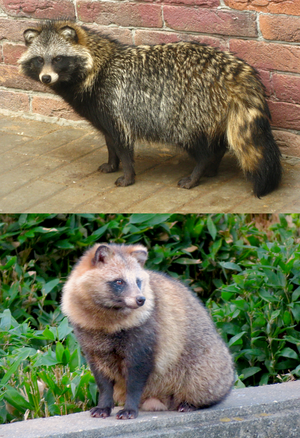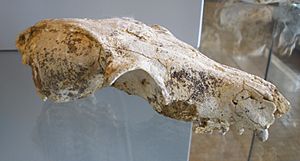Nyctereutes facts for kids
Quick facts for kids Nyctereutes |
|
|---|---|
 |
|
| Common and Japanese raccoon dog | |
| Scientific classification |
|
| Kingdom: | Animalia |
| Phylum: | Chordata |
| Class: | Mammalia |
| Order: | Carnivora |
| Family: | Canidae |
| Subfamily: | Caninae |
| Genus: | Nyctereutes Temminck, 1838 |
| Type species | |
| Canis viverrinus Temminck, 1838
|
|
| Species | |
|
N. procyonoides |
|
Nyctereutes (say: Nick-ter-OO-tees) is a group of animals that includes two living species. These are both known as raccoon dogs. The name Nyctereutes comes from Greek words meaning "night wanderer."
The two main types of raccoon dogs are the common raccoon dog (Nyctereutes procyonoides) and the Japanese raccoon dog (Nyctereutes viverrinus).
Raccoon dogs first appeared about 5.5 million years ago in northern China. They were among the first dog-like animals to live in the Old World (Europe, Asia, and Africa). Most species of Nyctereutes died out before the end of the Ice Age. Scientists believe that changes in the environment, like forests growing and shrinking, and shifts in temperature, affected how these animals evolved.
What Raccoon Dogs Look Like
Raccoon dogs usually have short noses and round heads. You can also tell them apart by the shape of their teeth, especially their molars.
These animals are known for eating many different things. They are opportunistic carnivores, which means they eat whatever food they can find. This includes small mammals, fish, birds, and insects. Sometimes, they also eat plants, especially roots. What they eat mostly depends on where they live.
Japanese raccoon dogs are a bit different from those on the mainland. They have larger skulls, especially the ones found in Russia and Hokkaido, Japan.
Types of Raccoon Dogs
There are two main types of raccoon dogs that are still alive today.
Living Species
| Image | Scientific Name | Where They Live |
|---|---|---|
 |
Nyctereutes procyonoides | Mongolia, Russian Far East, China, Korea, Vietnam; also brought to Europe |
 |
Nyctereutes viverrinus | Japan |
Extinct Species
Besides the two living species, there were several other types of Nyctereutes that are now extinct. These are known from fossils found in different parts of the world.
- †Nyctereutes abdeslami (lived 3.6 to 1.8 million years ago in Morocco)
- †Nyctereutes donnezani (lived 9.0 to 3.4 million years ago in Eastern Europe, Spain)
- †Nyctereutes lockwoodi (lived 3.42 to 3.2 million years ago in Ethiopia)
- †Nyctereutes megamastoides (found in Europe)
- †Nyctereutes sinensis (lived 3.6 million to 781,000 years ago in Eastern Asia)
- †Nyctereutes tingi
- †Nyctereutes vinetorum
See also
 In Spanish: Nyctereutes para niños
In Spanish: Nyctereutes para niños


